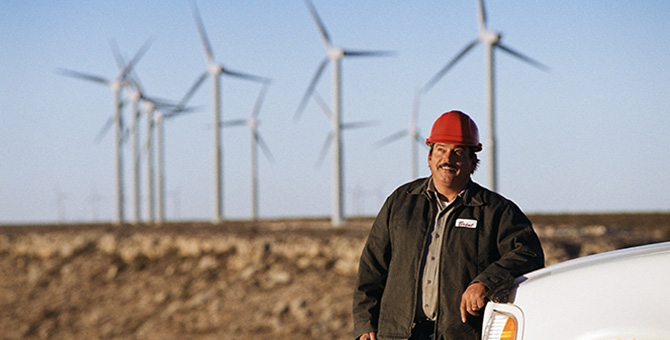In late 2021, the San Francisco Fed kicked off a series of roundtable discussions on climate-related risks with community development professionals who work in low- and moderate-income (LMI) communities and communities of color.
Our most recent roundtable focused on understanding the impact of climate risk on LMI communities, specifically in terms of access to job opportunities and workforce development. Climate adaptation and resilience efforts are already creating new and retooled jobs. The roundtable conversation underscored the opportunity at hand for the community development field to help accelerate workforce readiness in the climate resilience space, and to hear what the gaps and opportunities are for promoting equity and economic competitiveness in jobs, apprenticeships, and training programs geared towards clean energy and reducing climate risk for low- and moderate-income communities and communities of color.
Participants in the roundtable included workforce development and training providers, technical assistance providers, labor standards researchers and policy experts, and representatives from the utility and public sectors, as well as Tribal government—all of whom are focused on climate-related workforce development. Here’s what we heard.
Promoting job growth and business opportunities through new funding, increasing standards, and additional demands
Federal funding
Participants discussed new federal funding coming from the federal Inflation Reduction Act (IRA) and the Infrastructure Investment and Jobs Act (IIJA), which will likely lead to more jobs that support clean energy and climate resilience. Participants noted that many of these jobs are already high quality with built-in career ladders. As one participant said:
“The trades that have the most impact in lowering [energy usage and costs] are electrical, plumbing, mechanical, HVAC. Those are all pretty much either union trades, certified or licensed trades, depending on where you live, and more importantly, really high-earning, good wage jobs. So I think we’re kind of lucky in that…a high-road job, one with good salary and benefits and opportunities, also, happens to merge quite nicely with clean energy.”
The IIJA increases funding for the federal Weatherization Assistance Program and for the Energy Efficiency and Conservation Block Grant, both of which fund state efforts to improve home resilience and reduce home energy burdens for low- and moderate-income populations. Both the IIJA and the IRA have requirements and/or incentives for prevailing wage apprenticeships.1, 2, 3
An increase in sector standards
Participants expressed that some jobs that are seeing growth due to increased climate risk and resilience work could increase standards to make the sector more sustainable. For example, federal wildfire firefighters in California make less than the state minimum wage. One participant pointed to the potential role of the public sector in raising the bar, noting that “public agencies have a critical role to play in how they utilize resources, and there are policies that they can adopt to ensure that workforce development…[and] hiring criteria can be a priority…to assess what projects get funded.” Community benefits agreements can be an effective tool to raise job standards, particularly when public investment is at play.
New businesses
In addition to job growth, participants discussed opportunities for starting businesses to meet demand from new investment in areas such as clean energy and energy efficiency. One participant anticipated new jobs in “emerging sectors like battery manufacturing and chip manufacturing and [related to] investments in electric vehicles, school buses, passenger vehicles, and transit.” Another participant noted that “we particularly look to communities of color to be a part of the solution…to be in the workforce [and] to be owners of businesses… So not just those that are employed, but those that are self-employed, and can employ others…within their communities.”
Disproportionate impact of climate risk in communities
The impacts of climate risk will disproportionately affect LMI communities because of where they are located and because of the current barriers they are facing to economic participation and employment.
According to one participant:
“The impacts of climate change are having a significantly larger effect on low-income communities and communities of color, in terms of their overall quality of life. From an air quality standpoint, the asthma rates…it just targets the same communities across the board.”
Another participant noted, “Workers who are in frontline BIPOC (Black, Indigenous, and people of color) communities, they are facing a very different set of circumstances around climate than workers who are in communities that have more adaptive capacity.”
Given the overlap between areas experiencing disproportionate climate effects and LMI communities, there remains the need for additional education, “because the reality of today is that there’s so many issues facing low-income communities, poor communities, communities of color, that when you started talking about climate, the correlation between what’s most important isn’t always there, and understandably so.”
Participants suggested that the best messengers to help explain the impact of climate risk on communities remain members of the community who have already developed a level of trust and accountability, which leads to true community partnership and understanding. At the same time, they noted that this messaging could be more effective if accompanied by “resources…, both financial and programmatic, to improve both climate outcomes at the community level…and improve [individuals’] day-to-day life.”
Scaling solutions requires new funding and business models
Participants noted that many climate resilience pilot programs in individual communities or cities have shown promising results, but the difficulty will be in scaling for larger impact. “I think we need new funding models and new business models for delivering both climate resilience and equity. If we continue to use the existing models, we will have challenges in actually having effective results,” said one participant.
Because workforce development is time intensive and requires substantial funding, “if those business models and financing models are not informed by the actual people on the ground who are adjacent to what’s happening, then we’re just wasting money.”
Partnerships remain key for equitable impact
Another key theme from participants was the need for new and expanded partnerships to prepare workers for opportunities in climate adaptation and resilience, particularly workers from groups that have not been well-represented in the trades: “So much funding and so many initiatives are coming down the pike to decarbonize, to improve and change our climate trajectory as it is. So isn’t it great and wonderful if we could include communities of color in that solution?”
Training partnerships can support career pathway development
One participant noted that California’s High Road Training Partnership (HRTP) “developed curricula and training certifications to help workers not only be certified as green janitors, for example, but also to get paid better, to develop career pathways.”
The HRTP piloted eight training partnerships with employers, workers, and labor unions or nonprofit worker centers to provide training and certification to workers in career-path jobs that support community climate resilience.4 Industries represented included healthcare, hospitality, transportation, freight/distribution/logistics, water/wastewater, building operations, and government.5 According to the participant, the “employer and union partnerships were tasked with connecting underserved populations with quality jobs that had a climate focus, and the approach was really focused on benefiting the communities that are most impacted by climate change.”
The HRTP program promoted equity as well as economic competitiveness in these industries by gathering real-time feedback from workers on barriers to racial and ethnic inclusion and from employers on the skills they need.6 Participants noted that the feedback piece is often missing or not well developed, leading training programs to be out of date with employer needs. One participant noted that the HRTP pilot program could experiment with new partnerships in workforce development by using unrestricted WIOA funds.7
Tailor training programs to match job skill needs
Another participant noted that, as an employer, they work to communicate their current skills needs to local training programs, while also keeping the qualifications listed in job postings current and cutting any unnecessary requirements.
They conduct internal review of job descriptions, asking “[do] descriptions that we currently have actually match what the job criteria really are? Are there artificial barriers in place that are stopping individuals who have the skill set and abilities to do the work from accessing a high paying job in this space? So we’re actually undergoing a redo of our entire job classifications within our organization…because if there’s a job that exists right now, where there’s a barrier…and it’s not necessary to do the job effectively, we’re looking at making those changes [to the posted job description].”
The same employer also shared their organization’s efforts to work directly with training programs on workforce development curriculum, as well as to recruit potential employees from under-resourced communities.
Climate risk–specific partnerships are emerging
Some workforce partnerships are arising in relation to specific climate risks. One participant noted a partnership between a regional nonprofit, community colleges, and regional workforce boards that arose from “an ask for a regional advisory [committee] with regard to forest management, because of the impacts of droughts, invasive species, and wildfires. And so, we’re seeing a large need in that industry sector.”
Continuing the conversation
As the SF Fed Community Development team wraps up our conversations on how climate-related risks impact low- and moderate-income communities and communities of color, we will review what we’ve heard and share our findings in a forthcoming report. Please join our mailing list to continue learning with us.
More from the Understanding Climate Risk series:
- What We Learned from Twelfth District Utility CEOs
- What We Learned from CDFIs
- What We Learned from Twelfth District Agriculture CEOs
Notes
1. Congress.gov. “Text – H.R.5376 – 117th Congress (2021-2022): Inflation Reduction Act of 2022.” August 16, 2022. http://www.congress.gov/.
2. Department of Energy. “DOE Fact Sheet: The Bipartisan Infrastructure Deal Will Deliver for American Workers, Families and Usher in the Clean Energy Future.” November 9, 2021. https://www.energy.gov/.
3. National Governors Association. “What the Infrastructure Package Means for Workforce Development: Opportunities for Governors.” November 15, 2021. https://www.nga.org/.
4. California Workforce Development Board. “High Road Training Partnerships.” https://cwdb.ca.gov/.
5. Ana Luz González-Vásquez, Magaly N. López, & Javier Garcia-Perez. The High Road to Economic Prosperity: An Assessment of the California Workforce Development Board’s High Road Training Partnership Initiative. May 2021. UCLA: Institute for Research on Labor and Employment. https://www.labor.ucla.edu/publication/highroadreport/.
6. ibid.
7. WIOA, the Workforce Innovation and Opportunity Act, funds state-level workforce development programs through the US Department of Labor.
The views expressed here do not necessarily reflect the views of the management of the Federal Reserve Bank of San Francisco or of the Board of Governors of the Federal Reserve System.


